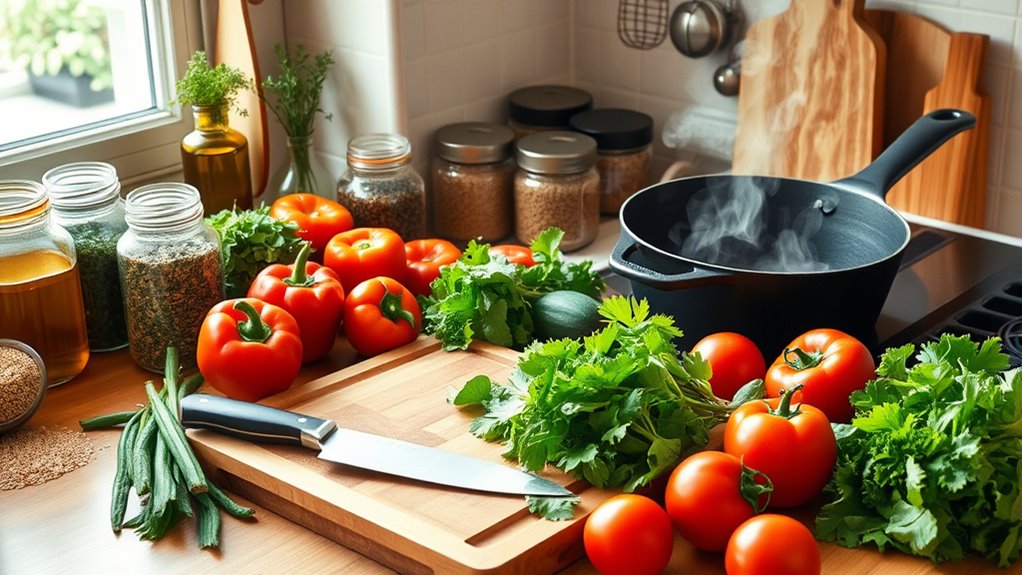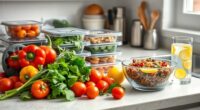To cook healthy meals, you’ll want essential cookware like non-stick pans and silicone spatulas for easy, oil-efficient cooking. Invest in appliances like air fryers and smoothie blenders to prepare nutritious dishes quickly and safely. Stock your pantry with whole grains, healthy oils, and legumes, and store produce properly to keep nutrients fresh. Master basic techniques like steaming, sautéing, and proper portioning. Continue exploring to discover how these tools and tips can support your healthy eating goals.
Key Takeaways
- Use non-stick cookware and silicone utensils to reduce oil and prevent surface damage, supporting healthier meal preparation.
- Incorporate essential appliances like air fryers and smoothie blenders for nutritious, low-oil cooking options.
- Stock pantry staples such as whole grains, healthy oils, and legumes to ensure nutrient-rich meal bases.
- Properly store produce using perforated bags and crisper drawers to maximize freshness and nutrient retention.
- Plan meals with balanced ingredients and batch prep to promote portion control and consistent healthy eating habits.
Essential Cookware and Kitchen Tools
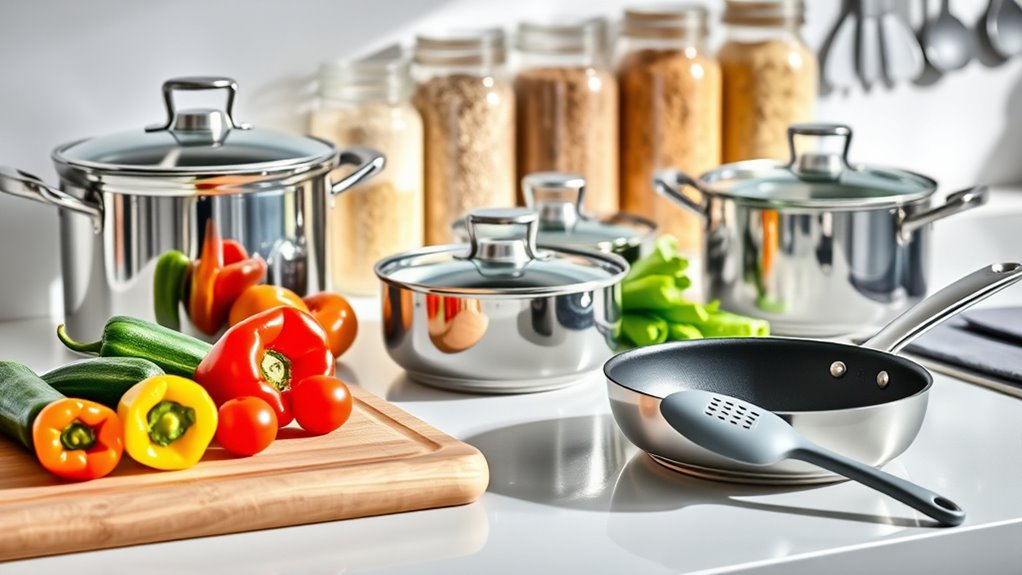
Having the right cookware and kitchen tools can make healthy cooking much easier and more enjoyable. Non-stick pans are essential because they require less oil, helping you prepare healthier meals without sticking or burning. Look for durable options that distribute heat evenly for consistent results. Silicone spatulas are a must-have because they’re gentle on non-stick surfaces and withstand high temperatures, making stirring and flipping easier. They let you scrape every bit of food from your pans, reducing waste and mess. These tools streamline your cooking process, encouraging better habits and more nutritious meals. Proper tool selection can also prevent damage to your cookware, extending its lifespan and ensuring consistent performance. Using appropriate cookware can improve heat distribution and cooking efficiency, which is vital for preparing healthy dishes. The ease of cleaning of these tools further supports maintaining a healthy and hygienic kitchen environment, making your healthy eating journey more sustainable. Additionally, selecting filters and protective equipment designed specifically for your tools can help maintain their longevity and optimal function.
Must-Have Kitchen Appliances for Healthy Cooking
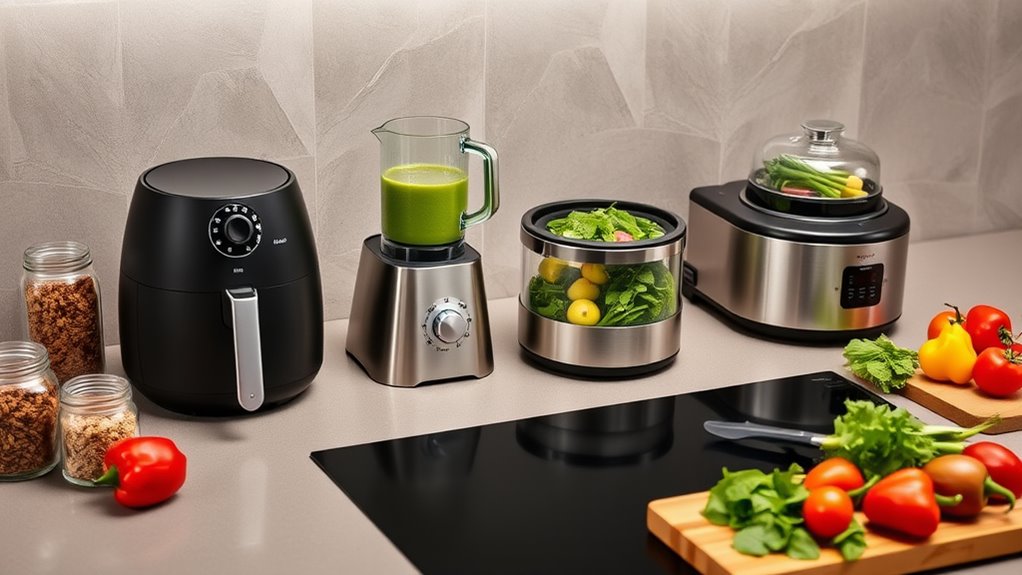
To make healthy cooking easier and more efficient, investing in the right kitchen appliances is essential. An air fryer is a versatile tool that lets you prepare crispy, delicious meals with less oil, perfect for creating healthy air fryer recipes. It speeds up cooking times and keeps nutrients intact, making it ideal for quick, nutritious meals. Additionally, upgrading your kitchen with smoothie blender options allows you to effortlessly whip up nutrient-packed smoothies and beverages. Look for blenders with multiple speed settings and powerful motors to blend fruits, vegetables, and even nuts smoothly. These appliances help you maintain a healthy diet by simplifying meal prep and snack creation. Color accuracy in your appliances can also enhance the visual appeal of your healthy dishes, making them more enticing. Incorporating kitchen safety features into your appliance choices can further enhance safe cooking practices. Modern appliances with safety sensors can alert you to potential hazards, ensuring a safer cooking environment. Embracing technological advancements in kitchen equipment can lead to more efficient and health-conscious cooking experiences. With the right appliances, you’ll find healthy cooking more enjoyable, convenient, and sustainable every day.
Nutritious Pantry Staples and Ingredients
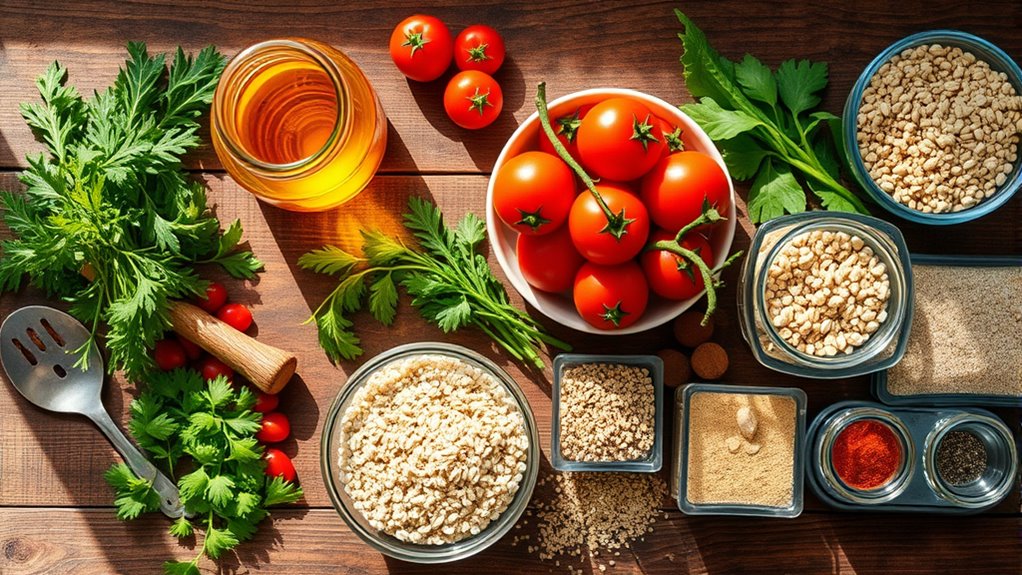
Stocking your pantry with whole grains, healthy oils, and nutrient-dense legumes sets the foundation for balanced meals. These ingredients boost your nutrition and keep cooking simple and flavorful. Let’s explore how to choose and incorporate these staples into your healthy eating habits. Embracing self-directed IRA can also inspire new ways to prepare your meals and make healthy eating an enjoyable experience. Incorporating meal planning tools can further streamline your shopping and cooking process, ensuring you maintain a nutritious diet with ease. Additionally, understanding natural techniques for seed production can inspire you to grow your own superfoods, enriching your pantry with homegrown chia or other nutrient-rich seeds.
Whole Grain Staples
Ever wondered which pantry staples can boost your healthy eating habits? Whole grains are a must-have. They offer numerous whole grain benefits, such as providing fiber, vitamins, and minerals that support digestion and overall health. Choosing whole grains over refined options guarantees you get more nutrients and sustained energy. Stock up on staples like brown rice, quinoa, oats, and whole wheat pasta. These ingredients are versatile and easy to incorporate into your meals. When shopping, look for labels that specify “100% whole grain” to ensure you’re making the best choice. Incorporating whole grains into your diet can improve heart health, aid weight management, and boost your energy levels. Keep these staples in your pantry to make healthy, wholesome meals effortlessly. Vetted options ensure you’re choosing reliable products that support your health goals. Additionally, being aware of the recognition of these grains can help you make more informed choices that align with your wellness objectives. Understanding the benefits of whole grains can motivate you to prioritize them in your daily meals. Being familiar with the Gold IRA options can also help diversify your investment portfolio for future financial security.
Healthy Cooking Oils
Choosing these oils wisely boosts your meal’s healthfulness and flavor. Incorporating the right oils can also reduce overwatering risk and support your overall diet by supporting nutritional balance and well-being. Additionally, understanding fat composition helps in selecting oils that align with your health goals.
Given the advancements in AI technology, staying informed about AI security is crucial to protect your health data and personal information.
Nutrient-Dense Legumes
Nutrient-dense legumes like lentils, chickpeas, black beans, and kidney beans are essential staples to keep in your pantry. These legume varieties are versatile and easy to incorporate into many dishes, from salads to stews. They offer impressive nutrient benefits, including high fiber, protein, vitamins, and minerals, which support digestion, muscle growth, and overall health. Legumes are a plant-based protein source that can help you reduce reliance on animal products while still meeting your nutritional needs. By stocking a variety of legumes, you ensure your meals stay interesting and nourishing. Plus, their long shelf life makes them a convenient option for quick, healthy eating. Incorporating nutrient-dense legumes into your diet is a smart way to boost your health without sacrificing flavor or convenience. Additionally, choosing organic seed cultivation methods can further enhance the nutritional quality of your legumes. Proper storage practices can help maintain their freshness and nutritional value over time. Maintaining a balanced diet that includes these legumes can positively impact your overall well-being. Using cookies responsibly can improve your browsing experience while maintaining your privacy preferences.
Fresh Produce and Storage Tips
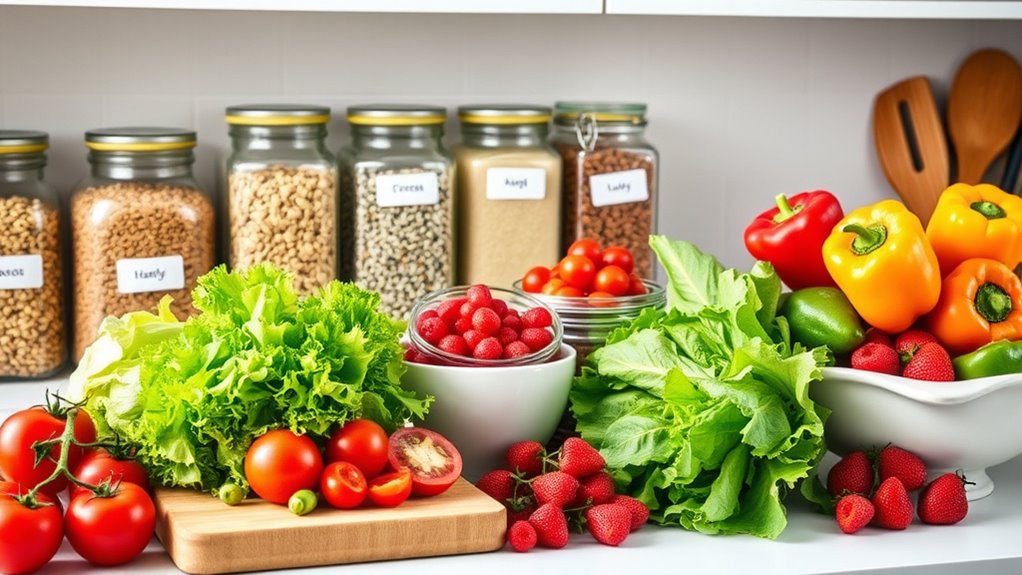
To keep your produce fresh and maximize its nutritional value, proper storage is essential. Store seasonal produce in breathable containers or perforated bags to prevent moisture buildup, which can cause spoilage. For leafy greens and herbs, use damp paper towels and keep them in the crisper drawer. Root vegetables like carrots and potatoes should be stored in a cool, dark, well-ventilated space. When choosing organic options, prioritize immediate consumption or refrigerate them promptly to preserve freshness and nutrients. If you buy in bulk, consider dividing produce into smaller portions to reduce waste and spoilage. Traditional storage methods can also be effective in maintaining produce quality. Proper storage not only extends freshness but also encourages healthier eating habits. Additionally, being aware of home security system costs can help you better plan your household expenses, ensuring your home remains safe while you focus on healthy living. Implementing proper storage techniques is part of a broader effort to maintain food quality and support your wellness goals.
Basic Cooking Techniques for Nutritious Meals
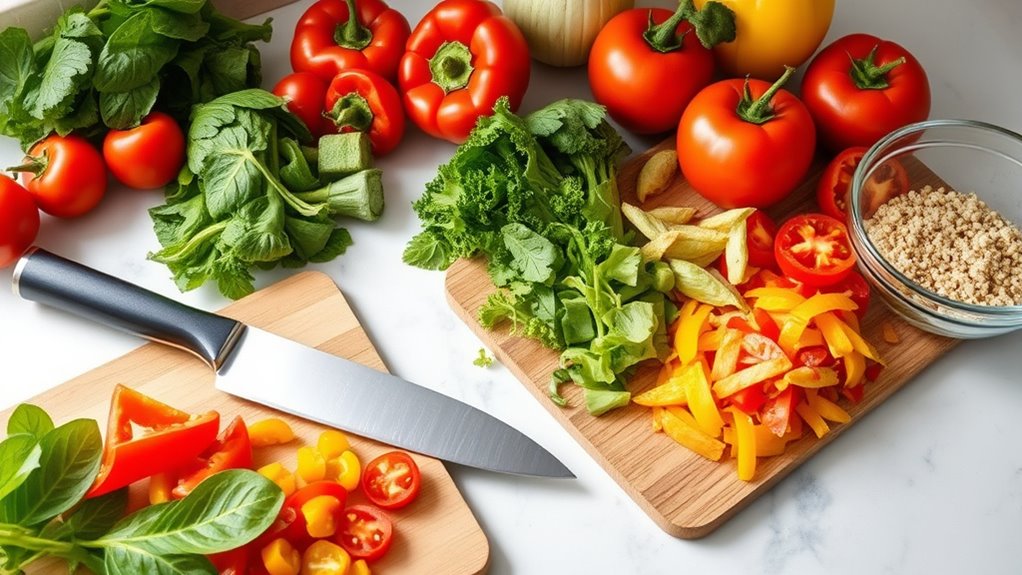
Mastering basic cooking techniques is essential for preparing nutritious meals that retain their flavor and nutrients. When you cook, prioritize cooking safety by handling knives carefully, avoiding cross-contamination, and cooking foods to proper temperatures. These safety measures help prevent foodborne illnesses and ensure your meals are healthy. Additionally, focus on flavor balancing by seasoning foods thoughtfully—using herbs, spices, and acids like lemon or vinegar to enhance taste without excess salt or sugar. Techniques like sautéing, steaming, boiling, and grilling preserve the nutrients in your ingredients while developing rich flavors. Learning proper timing and temperature control helps you avoid overcooking, which can diminish nutritional value. By mastering these techniques, you’ll make meals that are both safe and delicious, supporting your healthy eating goals.
Healthy Meal Planning and Preparation Tips
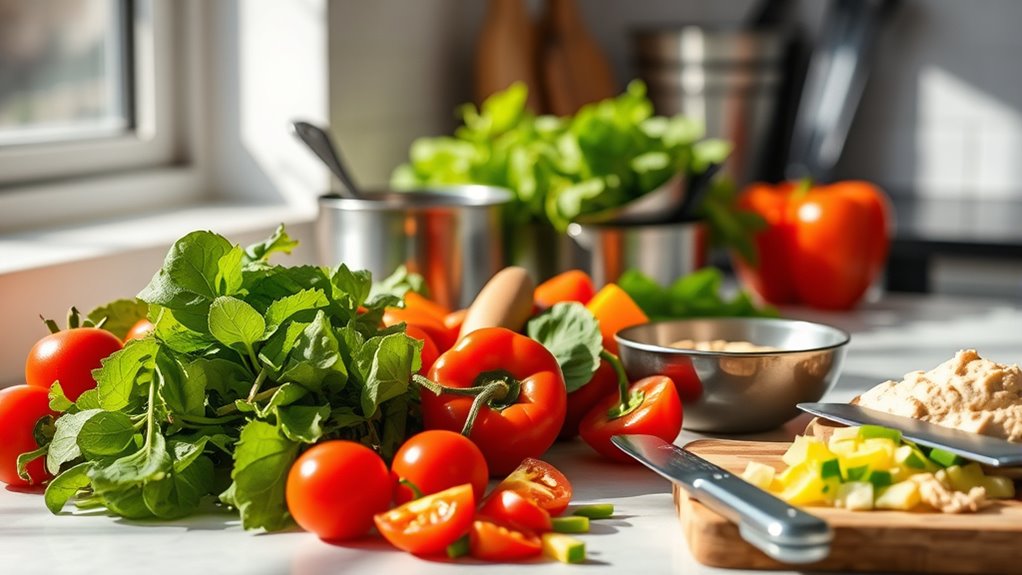
Effective healthy meal planning starts with setting clear goals and creating balanced menus that incorporate a variety of nourishing ingredients. To make this easier, develop meal prep strategies that save time and reduce stress during busy weekdays. Batch cooking and pre-portioning meals allow you to control ingredient quality and avoid impulsive unhealthy choices. Use portion control techniques by measuring servings or using smaller containers, ensuring you don’t overeat. Planning ahead helps you stick to your nutritional goals and balances macronutrients effectively. Keep a shopping list aligned with your meal plan to prevent unnecessary purchases. Incorporating these strategies makes healthy eating more manageable, keeps your meals satisfying, and supports long-term wellness. Consistent planning helps you stay committed and enjoy a variety of wholesome foods.
Frequently Asked Questions
How Can I Make My Meals More Flavorful Without Adding Extra Salt?
To make your meals more flavorful without extra salt, try herb enhancements like basil, oregano, or cilantro to add freshness. Spice combinations such as cumin, paprika, or chili powder can boost taste without sodium. You can also enhance dishes with citrus zest or vinegar for brightness. Experimenting with these options allows you to enjoy rich, satisfying flavors while keeping your meals healthy and low in salt.
What Are Some Quick Healthy Snacks I Can Prepare at Home?
You want quick, healthy snacks you can prepare at home? Focus on snack prep by gathering ingredients for healthy bites like sliced veggies with hummus, fruit with nut butter, or yogurt with berries. These options are easy to assemble and perfect for on-the-go. Keep a stash of nuts, seeds, and dried fruit for instant healthy bites. With a little prep, you can satisfy cravings without sacrificing nutrition or convenience.
How Do I Choose the Best Cooking Oils for Health?
You might find it interesting that choosing the right cooking oils often mirrors your cooking techniques and dietary fats. To make healthier choices, look for oils rich in unsaturated fats, like olive or avocado oil, which support heart health. Avoid trans fats and excessive saturated fats. Remember, a good balance in your oils, combined with mindful cooking techniques, helps you enjoy flavorful meals that nourish your body and soul.
Are There Any Tips for Reducing Sugar in Homemade Dishes?
To reduce sugar in your homemade dishes, start by experimenting with natural sweeteners like honey or maple syrup in small amounts. You can also incorporate fruit alternatives such as mashed bananas, applesauce, or pureed dates to add sweetness naturally. These options enhance flavor without extra refined sugar. Adjust recipes gradually to find the right balance, and taste as you go to avoid over-sweetening.
How Can I Incorporate More Plant-Based Proteins Into My Diet?
Imagine your plate as a vibrant canvas—adding more plant-based proteins transforms it into a masterpiece. You can incorporate vegetarian options like beans, lentils, tofu, and tempeh into your favorite dishes. Swap meat for these options in stir-fries, salads, or wraps. Not only do they boost your nutrient intake, but they also keep your meals exciting and balanced. Embrace the abundance of plant-based proteins and elevate your diet today.
Conclusion
By equipping your kitchen with the right tools, ingredients, and techniques, you create a vibrant space where healthy meals come to life. Picture chopping colorful vegetables on your cutting board, simmering fragrant herbs in a pot, and savoring the fresh aroma of a nutritious dish. With these essentials, you turn everyday cooking into a nourishing, flavorful journey. Embrace these habits, and watch your healthy eating habits blossom into a delicious, sustainable lifestyle.
